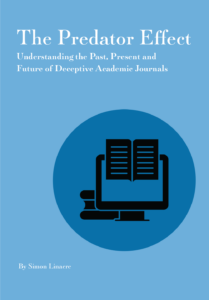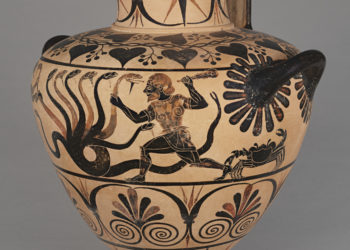Today Lisa Janicke Hinchliffe interviews Simon Linacre, author of the recently published book, The Predator Effect: Understanding the Past, Present and Future of Deceptive Academic Journals, and Head of Content, Brand & Press at Digital Science.
First off, congratulations on the publication of your book The Predator Effect. It is a notable accomplishment to get from an idea to a published monograph! What inspired you to write this text and what do you hope it will accomplish?
I think two things gave me motivation. Firstly, there was nothing out there at the time that gave the full picture on predatory publishing, either on predatory journals themselves or on the wider issues in scholarly communications that facilitated their emergence. Of course, a book did come out after I’d written it (Predatory Publishing by Jingfeng Xia), but our texts are from very different perspectives so I think they are complementary. And secondly, it was also the simple challenge of sitting down and writing something. It’s a small book. I took the #100daysofwriting challenge, which was a great way to structure the research and writing as well as keeping me focused. It actually took 119 days but I think that was OK!

How big a problem is predatory publishing? Why is it a problem?
There is a wide range of views on this. On one end of the spectrum is the view that there is little concern at all, that the numbers are overstated, or that one could argue that even major commercial publishers could be defined as predatory. On the other side there is the view that people and animals are being seriously hurt due to false or unvalidated research being presented as legitimate, or that millions of dollars of funding are being wasted on APCs for useless publications. I tend towards the latter view, mainly because I think a lot of the damage is yet to be recognized. Some publishers are starting to take citation leakage seriously, where citations from legitimate journals to illegitimate ones can undermine research publications. And who knows what research is being published behind a paywall or not at all due to concerns about publishing in open access journals — and one issue I wanted to put to bed in the book is the complete lack of any necessary tie between open access and predatory journals. I was also able to draw on some research I was involved in with respect to COVID-19-related research in predatory journals (an article on this is currently in review). We found those articles were likely to cover COVID-19 treatments, and were more likely to be cited, than other articles in predatory journals. If articles promoting hydroxychloroquine are being presented as legitimate and being cited in other journals, it strikes me as being a significant problem.
The term “predatory” has been heavily critiqued with some saying that the real predators are large, established publishers that charge high fees and make significant profits. What led you to decide to use the terms “predator” and “predatory” for the kinds of publishers and journals you discuss in the book?
I get the point that Bjorn Brembs and others are making about some publishers’ modus operandi, which stems from the somewhat broad definition that emerged in 2019. I define predatory publishing differently (see below), taking into account validation, which would preclude the publishers Brembs is addressing. Although, where I do have some sympathy is with authors who feel pressured by a constant stream of emails soliciting submissions, many of which do come from legitimate publishers.
However, perhaps the main point about the terminology is that since Jeffrey Beall coined the phrase in 2010 it has become inextricably linked with the group of journals that others call deceptive or fraudulent, and while I think synonyms such as ‘deceptive’ or ‘fake’ are useful, they don’t quite do the situation justice. (Plus, I use the word ‘predatory’ over 400 times in the book, so finding other words would have been pretty laborious!)
You point out in the text that some authors know exactly what they are doing with respect to their decisions to publish in some of these “predatory” journals. If a publisher isn’t deceiving its customers but rather providing a desired service, how would we then think about the obligation of that publisher to its non-customers (e.g., readers)?
In the book I propose a definition that highlights the deception of all stakeholders in journal publishing, not just authors:
“Predatory journals are deceptive and often fake, giving the appearance of legitimate peer-reviewed journals and impact academic stakeholders by exploiting the Open Access model while using misleading tactics to solicit article submissions.”
What predatory publishers are doing — whether authors are using them wittingly as a convenient service or not — is presenting scientific research when it has not been validated. The important aspect of the Federal Trade Commission (FTC) finding against OMICS International in 2019 was that it determined that this lack of validating process amounted to fraud when it was advertised as being present, and which authors and readers had a right to expect.
So, if an academic journal isn’t validating its content in some way, I’d argue it’s not an academic journal, because the validation element is essential to the act of publishing academic journals. This may seem like splitting hairs, but academic journals have provided validated content to authors — and readers and others in society — for over 350 years, and it’s that history that provides the expectation of a certain type of service.
How can a legitimate open access journal, particularly a new start-up that is independent of any of the long-established publishers, demonstrate that it isn’t predatory?
You’ll notice I have used the term ‘validated’ rather than ‘peer reviewed’, and that’s because we now have several emerging forms of scholarly content that have been validated in different ways than the traditional peer review process. (I say traditional, but peer review itself only became mainstream in the post-war period, so validation itself is perhaps more fluid than people realize.) For a new OA journal, the editors and publishers may decide to adopt peer review and validate it in various ways — by reporting on this process transparently, or by implementing open peer review, or by adopting a post-publication peer review like the F1000 model. I am a Trustee of COPE, and we deal all the time with cases where authors try to subvert systems, and one result of this is that systems offer increasingly better ways for legitimate publishing to flourish in the constant fight against bad actors. So for a new OA journal, I do think there has never been a better time to launch with the support there is for legitimate publishing processes.
Do you think we have reached “peak predation” and that the industry is getting the problem under control? Or, do you expect to see further expansion of these practices?
In terms of predatory journals, I would have to say ‘I hope so’. The profile of the practice has never been higher, and another reason I wanted to write the book is to play a small part in the gradual educational process. However, there are a couple of things that do worry me. There is still a significant lack of awareness about this issue. A study was recently published reporting that over 40% of Indian authors were unaware of predatory journals. One argument some people on the ‘predatory journals aren’t a problem’ side of the spectrum use is that it is just a matter of education, and if authors are informed they will see through the scams used by predatory publishers. But things in academia often move very slowly, and this education is neither well-coordinated nor well-conceived in many instances.
The other concern I have is that while we may have hit ‘peak predation’ for journals, we have yet to see the full impact in other areas. OA books have been well behind journals in their development, and as they become more mainstream I can see similar problems developing with predatory behaviors, if not on the same scale. Predatory conferences have also probably hit their peak after the pandemic, but the business model is there for online events as well – 1000 people paying $10 to give a virtual talk will generate the same revenue as 100 paying $100 to speak at an in-person event without the same overheads. And I have also written about predatory behavior in author support services where vulnerable authors can be deceived into spending hundreds of dollars on fake service providers.
As academic institutions become more devolved in terms of their structures and traditional ways of working, the shift in capital flow from B2B to B2C channels will open up markets ripe for predatory behavior to develop. This is one of the points I wanted to make in the book that I think many people have misinterpreted about OA. Open access was a vital and necessary progression in scholarly communications, but the economic reality was that it exposed individuals to a market in place of organizations, which made it much easier to exploit for nefarious actors such as predatory publishers. I wanted the book to explain this and other factors that both described the rise of predatory journals but also hopefully ways that prescribe their downfall.
Discussion
13 Thoughts on "The Predator Effect – Fraud in the Scholarly Publishing Industry: An Interview with Simon Linacre"
Thanks for doing this interview, Lisa and Simon.
For those interested, Simon’s book is free to download here.
Thanks, Rick! Given the subject nature, it was really important to make the book OA so many thanks go to Matthew Ismail, ATG Media, University of Michigan Press and Fulcrum for publishing it online and accessible to everyone.
Thanks, Simon, for making your book OA, and thanks Lisa for this fascinating SK interview.
This was tweeted by Peter Suber and Richard Poynder: “— and one issue I wanted to put to bed in the book is the complete lack of any necessary tie between open access and predatory journals.”
Sounds good!
But the only suggestion I found that the author is arguing for “a complete lack of any necessary tie” is on p. 22: “there is nothing inherently suspicious about OA journals”.
Explicit or implicit cause-and-effect connections between OA and predatory journals appear on pp. 2, 7 (quoting Beall), 12, 16, 17, 18, 25 (citing Beall), 44, 49, and 57-58. Perhaps the “lack of any necessary tie” message is not one that will be clear to many readers.
Just to clarify, the quote on P.22 and in the interview refer to the point that authors should not be suspicious of a journal just because it is OA. The references in the book refer to the environment that led to the development of predatory practices. Of course there is a link between predatory journals and OA, because predatory journals exploit the OA model – but the reason they are predatory has nothing to do with OA in and of itself, and everything to do with deception of authors.
I hope to read Linacre’s book, and this interview has some great insights, but I am concerned about the framing of predatory publishers as “bad actors.” Publishing articles is difficult and expensive, particularly for certain scholars in the Global South, and predatory publishing will inevitably continue to fill a niche unless publishing becomes more equitable. Otherwise, we are just playing Whac-A-Mole.
On a side note, I like the “validation” terminology—will we see a long-term shift toward this term?
I am glad you like the term ‘validation’ as I spent a lot of time thinking about what distinguishes good publishing practice and predatory journals. I hope the book makes clear that predatory journals do not legitimately fill a niche – they may deceive authors into thinking they do, but if an academic author wants validation by publishing their research then predatory publishers are not providing any kind of service. The intention of predatory publishers is to defraud authors of money, so they are bad actors – the fact that robust alternatives are difficult to find does not change that in my view.
The obvious question — if providing an attestation of validation is what separates the legit journals from the predators, where does eLife stand? Their new policy is to not make that judgement about submitted papers, rather to supply reviews which will be published alongside the papers, regardless of whether their contents are valid.
True, but eLife itself has earned legitimacy in other ways, and it is being transparent in showing the reviews of papers, good or bad. Predatory journals don’t supply reviews (because they don’t do them), but say that they do.
Which cuts to the difficulty of pinning down a singular definition of a “predatory journal”. I always liked Rick Anderson’s idea of using a list of qualifiers:
https://scholarlykitchen.sspnet.org/2015/05/11/should-we-retire-the-term-predatory-publishing/
When evaluating conference organizers for their trustworthiness this is the main criteria I focus on (https://blogs.tib.eu/wp/tib/2022/11/24/confidents-predatory-conference-identification-workflow/): Do they make a claim about important aspects of their conference or organization that is (intentionally) false and thereby deceptive? If it would be the norm at some point to for example report review processes (and how they are conducted) more transparently like eLife does, predatory organizers and publishers would find it more difficult to lie about these things. Now they can simply say: “Yes, we conduct a review.” With more transparency as the norm you would expect them to prove it and deception becomes at least much more labour-intensive or not feasable at all anymore.
Making academic publishing more equitable can’t be divorced from other global economic barriers, but most of the major subscription global publishers have schemes to provide free or very low-priced digital access to the full range of their journals to poorer countries. These schemes are essential to enable a prospective author to cite recent articles, as out of date references will fail peer review. With pay-wall journals there is no fee payable by the author, and major OA publishers will often waive publication fees. Taylor & Francis has an extensive co-publication programme with regional journals in the global south, there are many other initiatives such as INASP that are making a real difference.
The rise of open access journals has opened a widow of opportunities for scholars to have free and fast access to scientific knowledge to a level undreamed of few years ago. However, many journals, especially from India and Pakistan are predatory interms of charge fee. It is a cash and carry market. When journals promise to publish within 3 days, many stages in peer review must have been compromised. This makes the journal really predatory.



